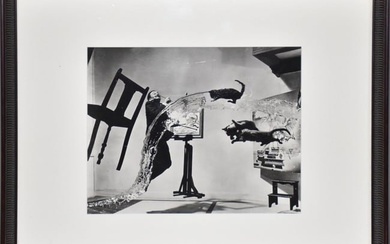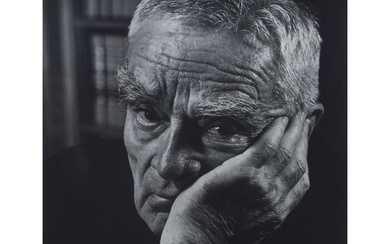PHILIPPE HALSMAN (Riga, 1906 – New York, 1979). "Jean Cocteau, the multidisciplinary artist"
PHILIPPE HALSMAN (Riga, 1906 - New York, 1979).
"Jean Cocteau, the multidisciplinary artist", 1949.
Photograph on silver gelatin.
Presents signature, and stamp "Copyright by Philippe Halsman" on the back.
Sizes: 18.5 x 15.5 cm; 42.5 x 39.5 cm (frame).
Halsman studied electrical engineering in Dresden, after being accused of the murder of his father, he spent two years in prison. On his release Halsman decided to move to France, where he began contributing to fashion magazines such as Vogue and soon earned a reputation as one of the best portrait photographers in France. Famous for his sharp rather than soft-focus, tightly cropped images. When France was invaded by Germany, Halsman fled to Marseille. He eventually managed to obtain an American visa, with the help of his family friend Albert Einstein, whom he later photographed in 1947. Halsman had his first success in the United States when the cosmetics firm Elizabeth Arden used his image of model Constance Ford against the American flag in an advertising campaign for "Victory Red" lipstick. A year later, in 1942, he found work at Life magazine, photographing hat designs; in 1941 Halsman met the surrealist artist Salvador Dalà and they began collaborating in the late 1940s. The 1948 work Dalà Atomicus explores the idea of suspension, depicting three cats flying, a bucket of water being thrown and Dalà in the air. The title of the photograph is a reference to Dalà 's work Leda Atomicus, which can be seen on the right of the photograph behind the two cats. Halsman and Dalà eventually published a compendium of their collaborations in the 1954 book Dali's Moustache, which presents 36 different views of the artist's distinctive moustache. Another famous collaboration between the two was In Voluptas Mors, a surrealist portrait of Dalà next to a large skull, in fact a tableau vivant composed of seven nudes. In 1947 Halsman took what would become one of his most famous photographs of a mournful Albert Einstein, who during the shoot recounted his regret at his role in the United States pursuing the atomic bomb. The photo would later be used in 1966 on a US postage stamp and, in 1999, on the cover of Time magazine, when it called Einstein the "Person of the Century". In 1951, NBC commissioned Halsman to photograph several popular comedians of the time, including Milton Berle, Sid Caesar, Groucho Marx and Bob Hope. The photographer developed a philosophy of jump photography, which he called jumpology. He published Philippe Halsman's Jump Book in 1959, which contained an ironic discussion of jumpology and 178 photographs of famous jumpers.
Sale price
Estimate
Reserve
Time, Location
Auction House
PHILIPPE HALSMAN (Riga, 1906 - New York, 1979).
"Jean Cocteau, the multidisciplinary artist", 1949.
Photograph on silver gelatin.
Presents signature, and stamp "Copyright by Philippe Halsman" on the back.
Sizes: 18.5 x 15.5 cm; 42.5 x 39.5 cm (frame).
Halsman studied electrical engineering in Dresden, after being accused of the murder of his father, he spent two years in prison. On his release Halsman decided to move to France, where he began contributing to fashion magazines such as Vogue and soon earned a reputation as one of the best portrait photographers in France. Famous for his sharp rather than soft-focus, tightly cropped images. When France was invaded by Germany, Halsman fled to Marseille. He eventually managed to obtain an American visa, with the help of his family friend Albert Einstein, whom he later photographed in 1947. Halsman had his first success in the United States when the cosmetics firm Elizabeth Arden used his image of model Constance Ford against the American flag in an advertising campaign for "Victory Red" lipstick. A year later, in 1942, he found work at Life magazine, photographing hat designs; in 1941 Halsman met the surrealist artist Salvador Dalà and they began collaborating in the late 1940s. The 1948 work Dalà Atomicus explores the idea of suspension, depicting three cats flying, a bucket of water being thrown and Dalà in the air. The title of the photograph is a reference to Dalà 's work Leda Atomicus, which can be seen on the right of the photograph behind the two cats. Halsman and Dalà eventually published a compendium of their collaborations in the 1954 book Dali's Moustache, which presents 36 different views of the artist's distinctive moustache. Another famous collaboration between the two was In Voluptas Mors, a surrealist portrait of Dalà next to a large skull, in fact a tableau vivant composed of seven nudes. In 1947 Halsman took what would become one of his most famous photographs of a mournful Albert Einstein, who during the shoot recounted his regret at his role in the United States pursuing the atomic bomb. The photo would later be used in 1966 on a US postage stamp and, in 1999, on the cover of Time magazine, when it called Einstein the "Person of the Century". In 1951, NBC commissioned Halsman to photograph several popular comedians of the time, including Milton Berle, Sid Caesar, Groucho Marx and Bob Hope. The photographer developed a philosophy of jump photography, which he called jumpology. He published Philippe Halsman's Jump Book in 1959, which contained an ironic discussion of jumpology and 178 photographs of famous jumpers.







